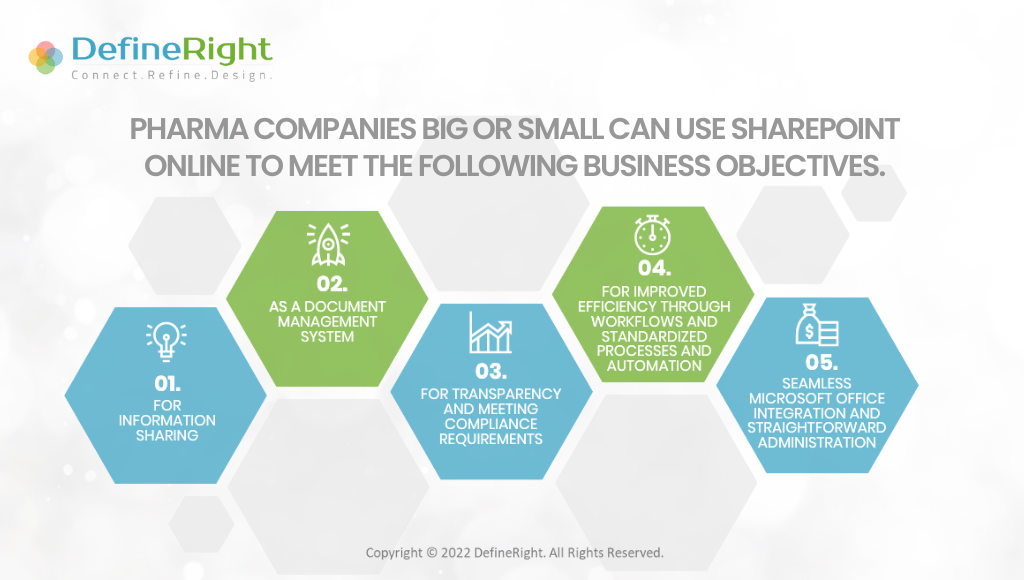
What Is SharePoint
Given the popularity of this tool among businesses globally, I do not think I need to start with this however it is always good to start with a definition.
SharePoint is a website-based collaboration tool uses workflow applications, “list” databases, and other web parts and security features to empower business teams to work together. SharePoint Online is the cloud version of SharePoint and has additional features and integration capabilities with other cloud applications.
SharePoint allows intranet-based collaboration features such as secure sharing, content management and workflow collaboration and many others.
How Can Pharma Companies Use SharePoint Online
Clinical development in Pharma is a complicated process that requires
- Sticking to processes that are regulated by compliance
- Regulatory Information Sharing and Access to Guideline Documents for everyday operations
- Multiple Cross functional teams working in parallel.
A lot of these can be achieved by using SharePoint Online. Most companies have the whole Microsoft Suite and that is why using SharePoint Online to address some of these business needs does not have additional licensing cost.
Pharma Companies big or small can use SharePoint Online to meet the following business objectives.

1. For Information Sharing
Pharma is a regulated and governed industry. People employed in Pharma thus spend a substantial amount of time looking for information to do their work. This information is often spread across multiple sources and portals, and even when they find it, they do not know if it is the recent most updated information. Business functions often prefer to create an information sharing platform on SharePoint.
However, what happens with SharePoint development is that since it is easy to develop, individual team members start building and maintaining their own sites. This causes too many sites, some of which may be duplicate and not all of it may be updated. That does not mean you cannot use your site for information sharing.
Have a process to manage the access on the site helps. As this is an information sharing site, majority of the people will need to only view the content on the site. Only a few will need to have the permissions to make changes to the content on the site. Managing access is paramount and one way to ensure that your site stays clean and serves the purpose it was created for.
It is also very critical to keep information sites updated for optimum usage. Maintain a repository of what content is there on the site and when was it last updated and then review it periodically. I have seen instances of functions where the org structure has changed but the changes have not been made on the business function’s site. If the content is not updated, people will not trust the site and not access it and the very purpose of building the site which was to save people’s time from going to multiple places to look for information will fail.
2. As a Document Management System
Document Management in Pharma, specifically within R&D can be defined as a repository of all documents that the different functions within your organization will be creating, managing, and maintaining during the drug development process. As I mentioned earlier that the drug development process is document intensive and requires the coming together of cross functional teams.
It is true that SharePoint provides an easy way to manage and maintain your documents. However, as the business function grows or the project gets more complex, maintaining the documents can get harder. That does not mean that you cannot use to for the purpose of document management. You can avoid that by having people responsible to act as gatekeepers for development of new site, setting up an intuitive site structure and outlining and clear content governance guidelines.
Have a central request management system where people can come in and request for SharePoint Sites. It helps if dedicated people across cross-functions are managing the requests. This set will act as your gatekeepers and save you from running into the problem of having too many sites.
Once you have your sites set up optimally, one should set up a Governance Review at a certain interval. Let us say every three months you look at the repository of your sites, use SharePoint inbuilt Analytics to see what is being used and what is not being used well, and streamline your sites appropriately.
3. For Transparency and Meeting Compliance Requirements
SharePoint Online also allows you to now build a validated environment for all your documents that are required by compliance to reside within a validated environment. You will need to create a clear separation between validated and non-validated environments, and you can have both such environments co-exist. The architecture is flexible and can be used for control.
Apart from providing robust access control based on user roles and permissions, SharePoint also provides multi-factor authentication, back up, automatic anti-malware protection and can generate alerts for sensitive information sharing.
You also have the audit log for tracking all activities including but not limited to user activity, including creating, accessing, editing, sharing, and deleting documents, plus user accounts and login information, site creation, and site settings changes
4. For Improved Efficiency Through Workflows and Standardized Processes and Automation
SharePoint Online allows you to use your business rules to create workflows and automate the whole process to make your operations efficient. If used judiciously this can be a great tool for your business function to create efficiency around some of the process intensive operations. I have seen many examples of business functions using SharePoint to create efficiencies for manually intensive business operations. Use cases such as people requesting for access and the approval workflow for the large number of systems within R&D, Storing and Validating Audit and Protocol Amendment Information, Approval Mechanisms for operations that have stepwise activities with approvals built in. This also allows people to see the values of automation first hand and then the business can decide on whether to invest in same or not.
There are of course companies that have Helpdesk tools for managing their IT Requests. For companies that are smaller SharePoint can be a great alternative. However, stick to the gatekeeper mechanism for building new sites, apps on SharePoint so you know that different people in your organization are not spending time in building the same thing in silo.
5. Seamless Microsoft Office Integration and Straightforward Administration
SharePoint Online now integrates with a bunch of other applications and that is why can be used for a variety of purposes. You can use it to control access to controlled documents, link it to your outlook and teams to create an efficient collaboration environment.
However, in the enthusiasm to build Sites in SharePoint do not forget to leverage the analytics that SharePoint provides on Site Usage. In these times when the user attention is ephemeral, leveraging SharePoint inbuilt Analytics to monitor the usage pattern becomes very important. Monitoring Site Analytics also acts as an input in your Site Governance mechanism. You can continue to streamline the number of sites you have as well as continue to update the content so that it helps increase usage on the sites.
It is not about technology or what we build. Technology changes every minute these days. For any technical solution if you can create the right ecosystem around the build, then it ensures you have a solution that will not become obsolete as soon as a business process changes.
At DefineRight we ensure that we help build sites when necessary but also use our discovery templates to streamline your existing SharePoint Sites. We also work with business functions to create governance mechanism around Site and Content Review and provide structure and roadmap for your entire SharePoint Development and Maintenance Practice. And most importantly, we encourage usage of SharePoint Analytics extensively for improved and data driven decision-making.
